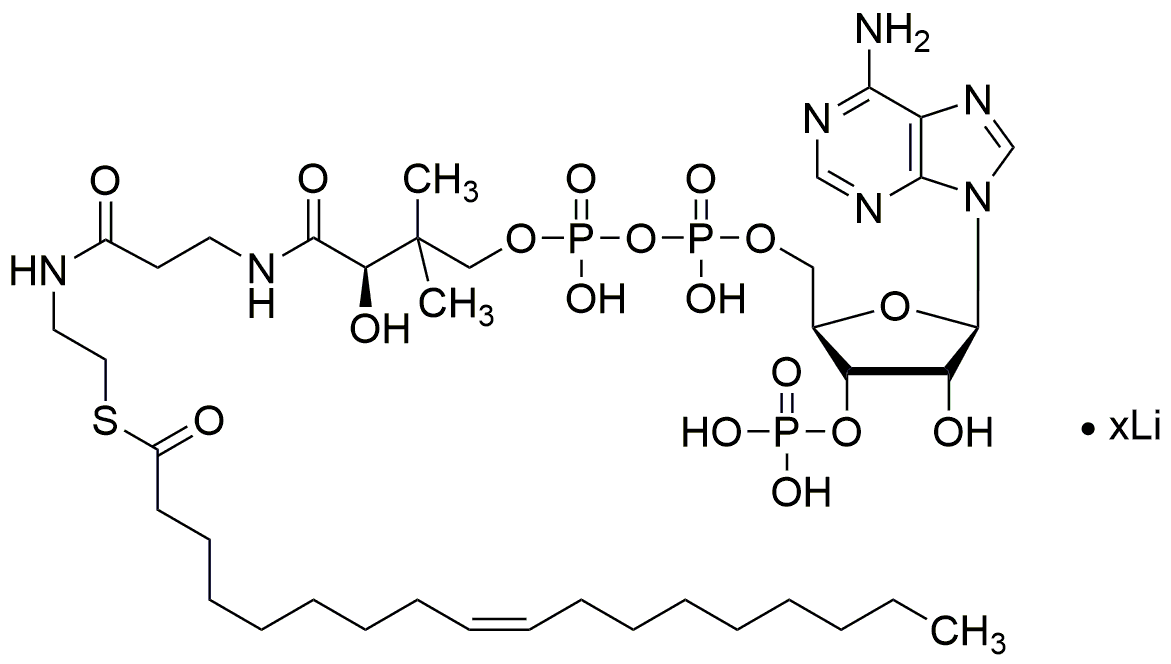Oleoyl coenzyme A lithium salt is widely utilized in research focused on:
- Biochemical Research: This compound plays a crucial role in metabolic studies, particularly in understanding lipid metabolism and energy production in cells.
- Drug Development: It is used in the formulation of pharmaceuticals aimed at treating metabolic disorders, offering a pathway to develop more effective therapies.
- Cell Culture Applications: Researchers employ this compound to enhance the growth and differentiation of specific cell types, aiding in tissue engineering and regenerative medicine.
- Enzyme Activity Studies: It serves as a substrate in assays to investigate the activity of various enzymes, providing insights into their mechanisms and potential inhibitors.
- Cosmetic Formulations: The compound is explored in the development of skincare products, leveraging its properties to improve skin hydration and barrier function.
Información general
Propiedades
Seguridad y normativas
Aplicaciones
Oleoyl coenzyme A lithium salt is widely utilized in research focused on:
- Biochemical Research: This compound plays a crucial role in metabolic studies, particularly in understanding lipid metabolism and energy production in cells.
- Drug Development: It is used in the formulation of pharmaceuticals aimed at treating metabolic disorders, offering a pathway to develop more effective therapies.
- Cell Culture Applications: Researchers employ this compound to enhance the growth and differentiation of specific cell types, aiding in tissue engineering and regenerative medicine.
- Enzyme Activity Studies: It serves as a substrate in assays to investigate the activity of various enzymes, providing insights into their mechanisms and potential inhibitors.
- Cosmetic Formulations: The compound is explored in the development of skincare products, leveraging its properties to improve skin hydration and barrier function.
Documentos
Hojas de datos de seguridad (HDS)
La SDS proporciona información de seguridad completa sobre la manipulación, el almacenamiento y la eliminación del producto.
Especificación del producto (PS)
La PS proporciona un desglose completo de las propiedades del producto, incluida la composición química, el estado físico, la pureza y los requisitos de almacenamiento. También detalla los rangos de calidad aceptables y las aplicaciones previstas del producto.
Certificados de análisis (COA)
Busque certificados de análisis (COA) ingresando el número de lote del producto. Los números de lote y de partida se pueden encontrar en la etiqueta de un producto después de las palabras "Lote" o "Lote".
Número de catálogo
Número de lote/lote
Certificados de origen (COO)
Este certificado de origen confirma el país en el que se fabricó el producto y también detalla los materiales y componentes utilizados en él y si se deriva de fuentes naturales, sintéticas u otras fuentes específicas. Este certificado puede ser necesario para cumplir con las normativas aduaneras, comerciales y regulatorias.
Número de catálogo
Número de lote/lote
Hojas de datos de seguridad (HDS)
La SDS proporciona información de seguridad completa sobre la manipulación, el almacenamiento y la eliminación del producto.
DownloadEspecificación del producto (PS)
La PS proporciona un desglose completo de las propiedades del producto, incluida la composición química, el estado físico, la pureza y los requisitos de almacenamiento. También detalla los rangos de calidad aceptables y las aplicaciones previstas del producto.
DownloadCertificados de análisis (COA)
Busque certificados de análisis (COA) ingresando el número de lote del producto. Los números de lote y de partida se pueden encontrar en la etiqueta de un producto después de las palabras "Lote" o "Lote".
Número de catálogo
Número de lote/lote
Certificados de origen (COO)
Este certificado de origen confirma el país en el que se fabricó el producto y también detalla los materiales y componentes utilizados en él y si se deriva de fuentes naturales, sintéticas u otras fuentes específicas. Este certificado puede ser necesario para cumplir con las normativas aduaneras, comerciales y regulatorias.


